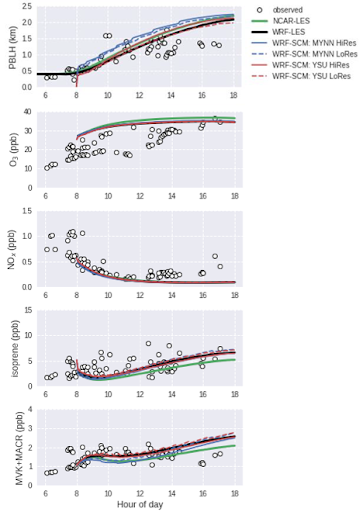Modeling Chemistry in the Boundary Layer
As part of the Boundary Layer Reinvestment Project, ACOM has developed the capability to run chemistry in WRF configured as a large eddy simulation and in WRF as a single column model. These tools have been applied to a typical day observed during the Southeast Atmosphere Study (SAS) in 2013. To have grid spacing of 15 meters in all three directions, a simple chemistry scheme was produced representing 19 chemical species and 41 reactions applicable to low-moderate NOx (~500 pptv) and high biogenic volatile organic compounds (up to 5 ppbv isoprene) appropriate for the Southeast US. The two WRF model configurations were performed in parallel to similar simulations by the NCAR LES model hosted in MMM and the CAM single column model hosted in CGD.
Preliminary results from WRF-LES, WRF-SCM, and NCAR-LES have been compared with observations from SAS. The plots shown below are time series of the planetary boundary layer height (PBLH) and modeled PBL averaged trace gases ozone, NOx (NO + NO2), isoprene, and combined methyl vinyl ketone and methacrolein (MVK- MACR) along with ground-based measurements of these trace gases. The models predict similar PBL heights and trace gas mixing ratios and are in line with observations. The LES models are being further analyzed to examine the variability and co-variability of trace gases to quantify the effect of turbulence on chemical reaction rates.
